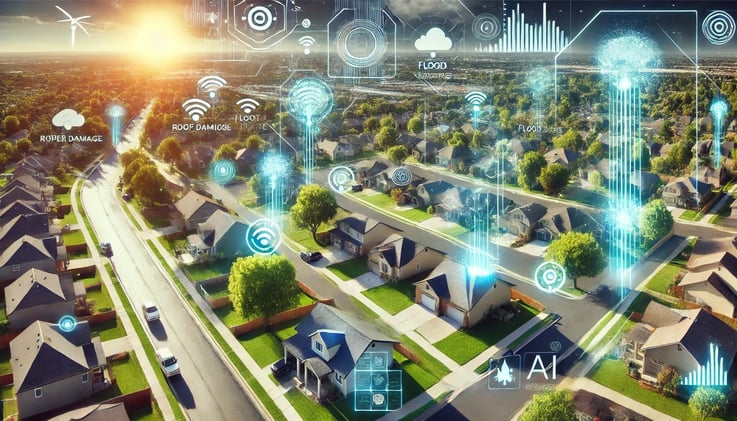Severe weather events continue to pose significant challenges to the insurance industry, as demonstrated by the catastrophic hurricanes that struck the southeastern U.S. in 2024. The unpredictability of these disasters is a stark reminder of the need for innovative solutions to mitigate losses and support policyholders.
The Problem with Reactive Insurance Practices
Historically, property and casualty (P&C) insurance has been reactive in nature, with claims often filed days or weeks after an event. This approach can lead to:
- Prolonged recovery periods for policyholders, causing frustration and distress.
- Expensive and time-intensive claims processes for insurers, resulting in increased costs and reduced profitability.
- Gaps in property risk data, limiting future preparedness and exacerbating the challenges posed by severe weather events.
However, advancements in artificial intelligence (AI) are transforming the industry’s approach to risk management. Tools like computer vision are enabling insurers to shift from reactive to proactive practices, improving efficiency, reducing losses, and enhancing policyholder experience.
What Is Computer Vision?
Computer vision is a branch of AI that uses machine learning models to analyze and interpret visual information from images. When applied to high-resolution aerial imagery, computer vision provides accurate insights into property conditions and vulnerabilities. For instance:
- AI-powered systems can evaluate over 100 property attributes, such as roof damage, potential wildfire paths, or flood risks.
- Early risk flagging allows insurers to identify vulnerabilities and mitigate potential losses, even in scenarios involving multiple large-scale disasters simultaneously.
AI’s Role in Managing Weather Risks
The adoption of AI technologies is critical for the insurance industry to effectively manage weather-related risks. Here are three key ways AI will transform the industry by 2025:
Proactive Risk Assessment Before the Storm
AI can analyze property conditions to identify vulnerabilities like aging roofs, structural risks, or hail exposure. Insurers can then proactively notify policyholders of preventative measures, helping to reduce the severity of future claims or avoid damage altogether.
Example:
- An insurer flags an aging roof susceptible to wind damage and advises the homeowner to reinforce it before hurricane season.
- The homeowner takes action, reducing the risk of costly repairs and improving their property’s resilience.
Rapid Damage Analysis After the Storm
Post-event, computer vision analyzes imagery to assess the extent of damage across properties. Insurers can use this data to:
Prioritize claims based on severity
- By analyzing damage patterns, insurers can focus on high-priority cases, ensuring that those most in need receive prompt support.
Expedite payouts to policyholders within 24-48 hours
- With AI-driven damage assessment, insurers can accelerate the claims process, providing faster relief to affected individuals and businesses.
- This approach also enhances trust between insurers and policyholders, as they experience improved responsiveness during challenging times.
Expanding Insurability in High-Risk Areas
Weather events are becoming more frequent and severe, leading some regions to be labeled ‘uninsurable.’ AI helps insurers reverse this trend by enabling granular property-level risk assessments. Instead of excluding entire areas, insurers can pinpoint properties that remain viable for coverage, even in traditionally high-risk zones.
Example:
- AI determines that a home built with advanced flood-resistant materials in a flood-prone area is still insurable.
- This decision opens up opportunities for tailored policies, providing policyholders with customized coverage and peace of mind.
The Benefits of AI Adoption
AI-powered tools offer numerous advantages for insurers:
Efficiency Gains
- Automating risk assessments and claims processing reduces costs and improves combined ratios.
- Insurers can allocate resources more effectively, streamlining operations and enhancing productivity.
Improved Policyholder Experience
- Faster claims resolutions and better risk communication strengthen customer trust and satisfaction.
- Policyholders experience improved responsiveness from insurers, fostering loyalty and retention.
Enhanced Risk Insights
- Granular property data improves risk modeling and portfolio management, helping insurers adapt to escalating weather risks.
- Insurers can refine their risk assessments, ensuring they’re adequately prepared for potential disasters.
Looking Ahead: Adapting to 2025’s Challenges
As insurers face the rising frequency and intensity of weather events, adopting AI technologies is no longer optional—it’s essential. Tools like computer vision, combined with aerial imagery and predictive analytics, will enable insurers to transition from reactive to proactive risk management.
To succeed, insurers must choose the right technology partners and solutions, ensuring their AI systems are tailored to their unique operational needs. By doing so, the insurance industry can better manage weather risks, improve efficiency, and deliver greater value to policyholders, even in the face of mounting challenges.
Conclusion
The adoption of AI technologies is critical for the insurance industry to effectively manage weather-related risks. By leveraging tools like computer vision, insurers can shift from reactive to proactive practices, improving efficiency, reducing losses, and enhancing policyholder experience. As the industry continues to evolve, it’s essential for insurers to prioritize innovation, ensuring they’re prepared to meet the challenges of an increasingly complex risk landscape.
In conclusion, AI is revolutionizing the insurance industry, enabling a more proactive and responsive approach to risk management. By embracing these advancements, insurers can build stronger relationships with policyholders, drive business growth, and ensure long-term success in a rapidly changing world.




